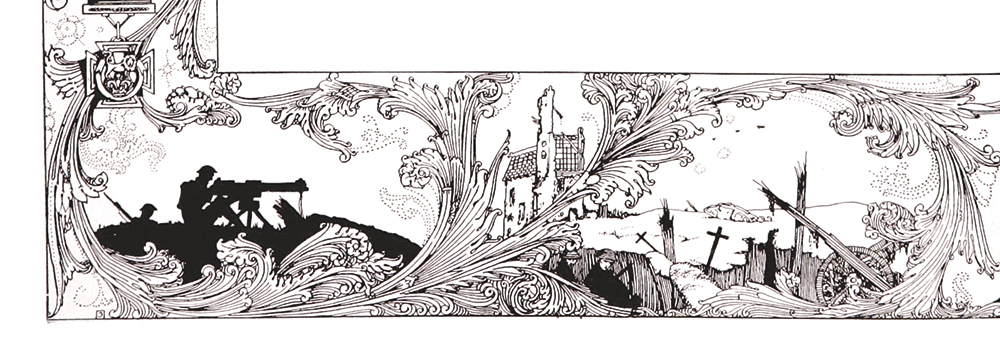Tracing First World War ancestors
Published in Features, Issue 4 (July/August 2014), Volume 22
Detail of a decorative border by Harry Clarke in Ireland’s Memorial Records 1914–1918, compiled by the committee of the Irish National War Memorial. (Eneclann)
British Army Service Records
Most researchers tracing an Irish First World War ancestor will start with the Army Service Records, the largest of all the British services. Their poor survival is one of the
reasons we have no definitive figures for the Irishmen who fought in this war. In 1940–1 approximately two thirds of all First World War soldiers’ service records were destroyed in the London blitz: of the original 6.5 million service records, only 2.5 million now survive. Recently findmypast re-indexed these ‘burnt records’, and in the process recovered the names and partial service files of over 600,000 soldiers whose records had been lost. For nearly a century these names have been obscured because they were incorrectly indexed. These ‘recovered’ names may significantly add to the numbers of Irish soldiers who fought in the Great War.
Medals
Several other sources bridge the gap in the British Army Service Records. Everyone who served overseas was entitled to a British and Victory (Campaign) medal. Inevitably, fewer medals were awarded for gallantry or distinguished service. When awards were given, however, it was published with a ‘mention in the dispatches’ in the London Gazette. In addition to the traditional British Armed Services, the medal cards include women’s services, the Indian Army and some civilians. The UK National Archives, Kew, holds over 5.5 million First World War army medal cards, now accessible on-line. The medal cards include the recipient’s name, service number, rank and unit.
Navy
Between 1914 and 1918 Irishmen also served in the Royal Navy, the Merchant Navy and the Royal Air Force, which came into being on 1 April 1918, formed from the Royal Flying Corps and the Royal Naval Air Service. Naval and Air Force records survive intact and are currently being digitised. Some are already available on the UK National Archives website.
Commonwealth War Graves Commission
It’s usually easier to trace those Irish soldiers who died, because they appear on the Commonwealth War Graves Commission (CWGC) website, and also in the eight-volume Harry Clarke-illustrated Irish war dead. Currently Google is sponsoring a project in which Eneclann and the In Flanders Fields Museum are updating the CWGC lists, correcting errors and including many soldiers not previously named in the official records. Independent scholars like Tom Burnell and groups like the Mayo Peace Park are preparing county records of the Irishmen who fought and died in the Great War and have already added hundreds of names for each county surveyed. Local newspapers and church memorials are incredibly useful in this endeavour, as they recorded the men and women in their locality.
‘Shot at dawn’
Many men who served between 1914 and 1918 took their own lives during or after the war. Others were court-martialled and shot for refusing to engage in the mindless carnage of trench warfare. The list of 340 individuals ‘shot at dawn’ includes men serving in the Royal Dublin Fusiliers and the Royal Irish Rifles. These names are also omitted from the official records. Their stories deserve to be told and their names included amongst the Irish war dead.
Perhaps by the close of the centenary commemorations in 2018 we may actually have a clearer idea of how many Irish people were involved in the First World War. Recovering their names and personal histories is not simply an exercise in collating names—it’s a means of reclaiming our own historical narrative.
Fiona Fitzsimons is director of Eneclann, a Trinity College campus company, and of findmypast Ireland.
Further reading
British Army medal index cards 1914–1920, www.nationalarchives.gov.uk/records/medal-index-cards-ww1.htm.
Commonwealth War Graves Commission, www.cwgc.org/.
In Flanders Fields Museum, www.inflandersfields.be.
Royal Navy Service records, www.nationalarchives.gov.uk/
records/royal-naval-seamen.htm.
search.findmypast.ie/search-world-Records/british-army-service-records-1914-1920.
Shot at dawn, http://en.wikipedia.org/wiki/Shot_at_Dawn_Memorial.


















